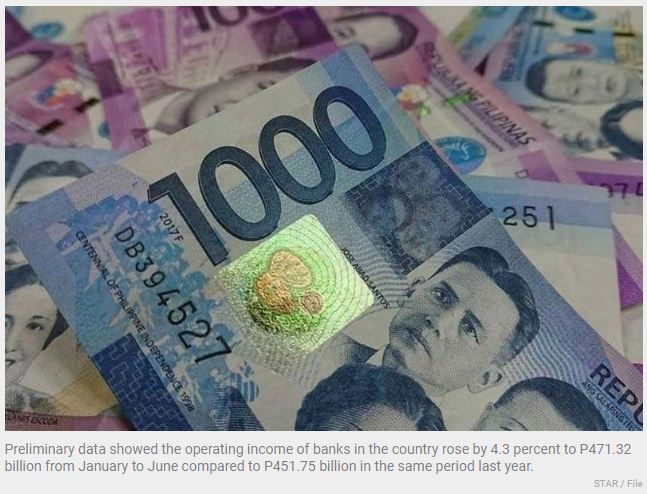Earnings of Philippine banks up 16.7%
MANILA, Philippines — Earnings of Philippine banks went up by 16.7 percent to P143.12 billion in the first half from P122.67 billion in the same period last year, data from the Bangko Sentral ng Pilipinas (BSP) showed.
Preliminary data showed the operating income of banks in the country rose by 4.3 percent to P471.32 billion from January to June compared to P451.75 billion in the same period last year.
The sector’s net interest income increased by 8.8 percent to P354.32 billion from P325.58 billion as interest earnings went up by 6.4 percent to P409.4 billion from P384.92 billion, while interest expenses slipped by 6.9 percent to P54.97 billion from P59.06 billion.
Likewise, banks’ non-interest earnings declined by 7.2 percent to P117 billion from P126.16 billion, as profits on the sale of other assets plunged by 66.9 percent to P19.99 billion from P60.34 billion.
During the first semester, fees and commissions earned by banks increased by 14.9 percent to P58.58 billion from P50.99 billion, while trading gains quadrupled to P10.35 billion from P2.58 billion.
According to the BSP, the non-interest expenses of banks climbed by 5.2 percent to P266.95 billion from P253.82 billion.
As the economy continues to recover from the pandemic-induced recession, Philippine banks are allocating less provisions for credit losses.
Data showed provision for bad debts fell by 26.7 percent to P45.65 billion in the first half from P62.27 billion in the same period last year, while the amount of soured loans written off dropped by 63.4 percent to P1.81 billion from P4.94 billion.
For universal and commercial banks, their net income grew by 16.1 percent to P131.82 billion in the first half from a year-ago level of P113.49 billion.
Sy-led BDO Unibank reported a 12-percent increase in net income to P23.9 billion in the first half, followed by state-run Land Bank of the Philippines with a 94-percent jump to P20.3 billion, Ty-led Metropolitan Bank & Trust Co. (Metrobank) with a 33-percent increase to P15.59 billion, and Ayala-owned Bank of the Philippine Islands (BPI) with a 73-percent surge to P20.4 billion.
Philippine banks bounced back as earnings surged by 44.8 percent to P224.75 billion from P155.22 billion in 2021 after plunging by 32.67 percent from P230.67 billion in 2020 due to the uncertainties brought about by the pandemic.
Fitch Ratings earlier said the current monetary policy tightening cycle in Asia-Pacific is favorable for Philippine banks as loans outgrew deposits in May for the first time since the pandemic.
The debt watcher said the loan or deposit ratio looks to have bottomed out in early 2022, and the deployment of excess liquidity into higher-yielding loans is poised to augment interest incomes, although persistent inflation could dampen the pace of loan growth.
According to Fitch, trading income does not constitute a large part of the major banks’ revenue, and mark-to-market losses on bond portfolios should be contained as debt securities held for trading comprise less than three percent of assets.
“The Philippines has one of the most liquid banking systems in Asia-Pacific,” Fitch said.
It added that the country also has a high proportion of rate insensitive current account and savings account (CASA) deposits, giving banks a strong ability to manage deposit costs.
“On the other hand, changes in the policy reverse repo rate have not historically been fully passed through to bank lending rates,” Fitch said.
Source: https://www.philstar.com/business/2022/08/11/2201751/earnings-philippine-banks-167


 Thailand
Thailand




